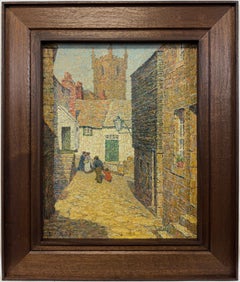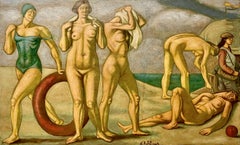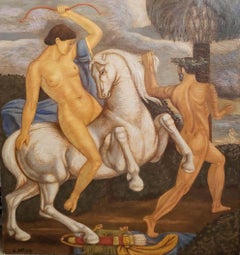Norbert Schlaus Art
American, German, 1927-2009
German-born Norbert Schlaus gravitated to a career as a painter and printmaker in his early years, following it with study at the Staatliche Akademie der Bildenden Kuenste, in Karlsruhe between 1947 and 1953. A decade later found him settled in Oakland, California where he lived and worked for the remainder of his life. Known for his muscular, cavorting nudes, Schlaus passed away in 2009. And today, his works remain part of the Oakland Museum of California’s permanent collection.1927-2009to
1
2
2
Overall Width
to
Overall Height
to
5
5
4
1
5
4
3
1
1
1
1
5
5
5
10,138
2,778
1,375
1,373
1
5
Artist: Norbert Schlaus
Two nude Couples
By Norbert Schlaus
Located in San Francisco, CA
This artwork "Two Nude Couples" is an oil painting on masonite board by noted German/American artist Norbert Schlaus, 1927-2009. It is signed at the lower left center by the artist. ...
Category
Late 20th Century Impressionist Norbert Schlaus Art
Materials
Oil
Two Nudes in a Landscape
By Norbert Schlaus
Located in San Francisco, CA
This artwork "Two Nudes in a Landscape c. 1980 is an oil painting on canvas by noted German/American artist Norbert Schlaus, 1927-2009. It is signed at the lower left corner by the a...
Category
Late 20th Century Impressionist Norbert Schlaus Art
Materials
Oil
The Fisherwoman
By Norbert Schlaus
Located in San Francisco, CA
This artwork "The Fisherwoman" c. 1980 is an oil painting on canvas by noted German/American artist Norbert Schlaus, 1927-2009. It is signed at the lower right corner by the artist. ...
Category
Late 20th Century Impressionist Norbert Schlaus Art
Materials
Oil
"Nude with Chair and Fruit" Large oil painting on canvas
By Norbert Schlaus
Located in San Francisco, CA
This artwork "Nude with Chair and Fruit" c. 1980 is a large oil painting on canvas by noted German/American artist Norbert Schlaus, 1927-2009. It is signed at the lower right corner ...
Category
Late 20th Century Impressionist Norbert Schlaus Art
Materials
Oil
Grinding Coffee
By Norbert Schlaus
Located in San Francisco, CA
This artwork "Grinding Coffee" c. 1980 is a large oil painting on canvas by noted German/American artist Norbert Schlaus, 1927-2009. It is signed at the upper left corner by the arti...
Category
Late 20th Century Impressionist Norbert Schlaus Art
Materials
Oil
Related Items
Landscape with characters spanish original oil on canvas painting
By Joaquim Marsillach i Codony
Located in Sitges, Barcelona
Joaquim Marsillach i Codony (1905-1986) - Landscape with characters
Oil on canvas
Oil measures 46x55 cm.
Frame measures 69x78 cm.
Marsillach Codony...
Category
1950s Impressionist Norbert Schlaus Art
Materials
Oil, Canvas
Joaquim Marsillach i CodonyLandscape with characters spanish original oil on canvas painting, c.1960
$861 Sale Price
20% Off
H 18.12 in W 21.66 in
“Village Street” by Mary Nicholena MacCord, American Impressionist European Town
By Mary Nicholena MacCord
Located in Yardley, PA
A wonderful view of a charming European town. This work captures the quiet intimacy of a cobbled lane, its golden stones leading the viewer toward a cluster of whitewashed and brick ...
Category
Early 20th Century American Impressionist Norbert Schlaus Art
Materials
Canvas, Oil, Board
$2,750
H 26.75 in W 22.75 in D 1.25 in
“Bermuda Coast” Henrietta Dunn Mears American Impressionist Oil on Board Signed
By Henrietta Dunn Mears
Located in Yardley, PA
A vibrant Bermuda seascape depicting the rocky shoreline with turquoise waters breaking against sunlit boulders beneath a sweeping tree. Mears uses bold, textured brushstrokes and a ...
Category
20th Century American Impressionist Norbert Schlaus Art
Materials
Oil, Board
$1,950
H 19.5 in W 23.5 in D 1 in
OLD MASTER Signed L S Lowry " Bridge Street Road " Oil Painting 20th Century GGF
By Laurence Stephen Lowry
Located in Ferndown, GB
OLD MASTER Signed L S LOWRY OIL PAINTING 20th CENTURY
NEW COLLECTION Of RARE PIECES OF OLD HISTORY
Here we have a unique and rare piece of Art signed
Goo...
Category
Mid-20th Century Impressionist Norbert Schlaus Art
Materials
Oil
$3,640
H 28 in W 24 in
Ernst Louizor ( 1938-2011 ) oil painting on board
By Ernst Louizor
Located in Hoddesdon, GB
Ernst Louizor (1938-2011) a beautiful oil painting on board. This vibrant artwork depicts a bustling village scene, elegantly mounted in its original carved wooden frame from Haiti. ...
Category
Mid-20th Century Impressionist Norbert Schlaus Art
Materials
Oil, Board
$1,648
H 20.87 in W 24.81 in D 1.19 in
“Autumn Landscape, c. 1910” American Impressionist New England Fall Oil Signed
Located in Yardley, PA
Warm air seems to move through this scene as the eye wanders along a gentle swale dotted with granite boulders, low stone walls and scrubby autumn color. A ribbon of meadow pulls us ...
Category
Early 20th Century American Impressionist Norbert Schlaus Art
Materials
Canvas, Oil
$3,500
H 29.5 in W 35.5 in D 2.5 in
OLD MASTER Signed Pissarro " The Busy Street " Oil Painting 20th Century GGF
By Camille Pissarro
Located in Ferndown, GB
OLD MASTER PISSARRO LARGE CANVAS OIL PAINTING 20th CENTURY FRAMED
“Good condition" ..Piece has been cleaned good condition for age
(see pictures)
OLD MASTER OIL PAINTING LARGE S...
Category
Mid-20th Century Impressionist Norbert Schlaus Art
Materials
Oil
"Model, Astone Studio" Contemporary impressionist oil painting, female nude
By Ben Fenske
Located in Sag Harbor, NY
After studying anatomy and academic painting at the Florence Academy of Art, Ben Fenske took the skills he learned and stepped back, putting his own hand into an academically proport...
Category
21st Century and Contemporary American Impressionist Norbert Schlaus Art
Materials
Canvas, Oil
$17,000
H 47.2 in W 35.4 in
Edinburgh Town circa 1930
By Charles Eddowes Turner
Located in Hillsborough, NC
Famous Edinburgh scene with the foggy Castle on the Mount from the North Bridge, and a bustling city scene below. Impressionist style, dating to mid 1920s/1930s, presenting a glimps...
Category
1930s Impressionist Norbert Schlaus Art
Materials
Canvas, Oil
$3,255 Sale Price
30% Off
H 28 in W 38 in D 1 in
“Covered Bridge, Kingston, NY, 1927” by Walter Koeniger, Snowy Winter Landscape
By Walter Koeniger
Located in Yardley, PA
Known for his evocative, snow-covered landscapes, Koeniger brings this subject to life with his bold, confident brushwork and keen eye for natural light. The composition centers arou...
Category
1920s American Impressionist Norbert Schlaus Art
Materials
Canvas, Oil
Walter Koeniger“Covered Bridge, Kingston, NY, 1927” by Walter Koeniger, Snowy Winter Landscape, 1927
$9,500
H 42.75 in W 44.5 in D 2.5 in
OLD MASTER Signed L S Lowry " Fever Van " Oil Painting 20th Century White Frame
By Laurence Stephen Lowry
Located in Ferndown, GB
OLD MASTER Signed L S Lowry " Fever van " Oil Painting 20th Century
NEW COLLECTION Of RARE PIECES OF ART
Here we have a unique and rare piece of Art signed
Good Detail one of the ...
Category
Mid-20th Century Impressionist Norbert Schlaus Art
Materials
Oil
$3,365
H 23 in W 27 in
"Male Curve" - Stunning Expressionist Figurative Nude in Muted Earth Tones
Located in Carmel, CA
Natalia Aandewiel (Ukrainian, born 1996)
"Male Curve" 2023
Oil Paint, Canvas, Stretcher Bars
The artist signed the back of the painting.
"Male Curve...
Category
2010s Impressionist Norbert Schlaus Art
Materials
Canvas, Oil, Stretcher Bars
$7,000
H 36 in W 24 in D 1.5 in
Previously Available Items
Muscular Nude Women Bathers at the Seaside
By Norbert Schlaus
Located in San Francisco, CA
No wilting roses here, these women have six-packs. Built with broad hips and firm stomachs, leading to muscled limbs, all proudly displayed here at water’s edge, they are modern Amaz...
Category
1950s Modern Norbert Schlaus Art
Materials
Canvas, Oil
Diana the Huntress
By Norbert Schlaus
Located in Los Angeles, CA
NORBERT SCHLAUS
"DIANA THE HUNTRESS"
OIL ON CANVAS, SIGNED
GERMAN-AMERICAN, C.1950
32 X 30 INCHES
Norbert Schlaus
1927-2009
Norbert Schlaus w...
Category
1850s Art Deco Norbert Schlaus Art
Materials
Canvas, Oil
Norbert Schlaus art for sale on 1stDibs.
Find a wide variety of authentic Norbert Schlaus art available for sale on 1stDibs. You can also browse by medium to find art by Norbert Schlaus in oil paint, paint, canvas and more. Much of the original work by this artist or collective was created during the 20th century and is mostly associated with the Impressionist style. Not every interior allows for large Norbert Schlaus art, so small editions measuring 28 inches across are available. Customers who are interested in this artist might also find the work of Albert de Belleroche, Ramon Pichot i Soler, and Jose Canes (Dore). Norbert Schlaus art prices can differ depending upon medium, time period and other attributes. On 1stDibs, the price for these items starts at $1,150 and tops out at $3,500, while the average work can sell for $2,500.


